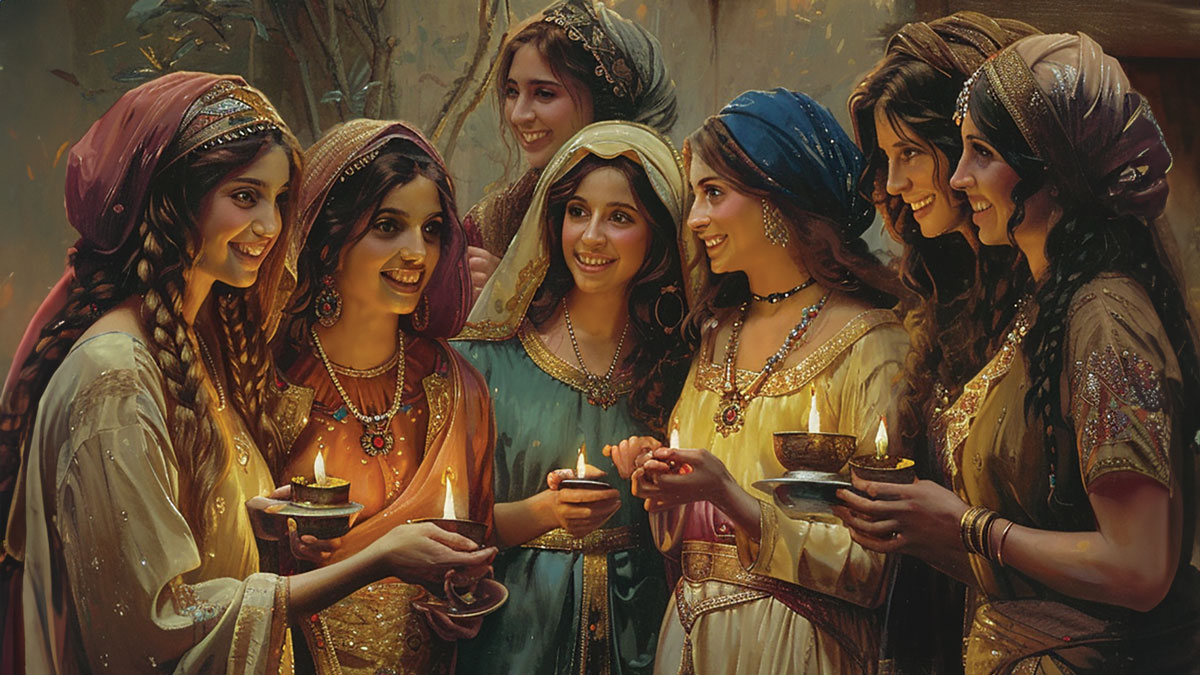The Kedron valley is drenched in the sepia tones of early evening as Jesus and His disciples gather on the mount of Olives. As they quietly talk, they notice in the distance a commotion. A small crowd of respectfully dressed people have gathered and appear to be waiting for someone or something. While it’s not unusual to see a crowd of people during the day, it is more unusual late in the day. What they are doing appears to be not only important but inevitable.
As they look closer, they see amongst the crowd a group that is distinct from the rest—10 young women excitedly chatting among themselves while occasionally glancing up the cobbled road. In their hands they hold something—a lamp.
The parable of the ten virgins (Matthew 25:1–13) is replete with prophetic symbolism and is placed in the middle of the Olivet Discourse which addresses end-time events, the importance of watchfulness and the vital significance of being ready.
Given the context and the prophetic nature of the entire block, we immediately recognise the symbolism used for a church throughout biblical prophecy—that of a woman.
If Revelation’s corrupt church is described in unflattering terms as a harlot, it seems appropriate to conclude that the “virgins” (Greek parthenois) of our parable represent a pure or undefiled church. In what way this “church” is “pure” or “undefiled” remains to be seen.
As we continue our evaluation, we can conclude that from a prophetic and biblical/Hebrew mind perspective, 10 is often associated with completeness, and order,1 the lamps represent the Word of God2 and the oil is a symbol for the Holy Spirit3.
The final symbolic strand we need to pull together relates to the object of their attention—the bridegroom, which is none other than Jesus Himself4.
So, what might we call a “church” who is into the Word while looking for and waiting for the coming of Jesus? Given the context of our parable which uses prophetic and symbolic language to describe end-time events, the importance of watchfulness and readiness—it could be logical to conclude that “Adventists” fit into this group.
Now that we have described more fully the symbolic particulars of our parable, and drawn some potential parallels to our own time, we need to turn our attention to the aspects of the parable that divide those who were prepared and those who were not—the lamps, or more specifically what the lamps were supposed to do.
According to the parable, having access to a lamp is not enough; it needs the capacity to illuminate. Indeed, lamps that do not provide illumination serve little to no purpose beyond being an ornament. A little commodity called oil makes all the difference, and five had oil and five did not.
So, it seems possible that one can be an “Adventist” into the “Word”, have a profession and yet lack the transforming power of the Holy Spirit who alone can effectively incorporate the principles of God’s kingdom, revealed in the Word, into the life which results in an illuminating life.
I’d like to suggest that this would be a catastrophic place to be. Imagine believing that you were ready and yet being ignorant of the fact that you were not! Indeed, one startling aspect of the parable is that the two groups were indistinguishable from each other until the midnight cry. This event woke the whole group from their apathetic, situational ignorance. Unfortunately, at that point it was too late to change the inevitable outcome. The resulting panic and rush from the foolish served as a pointless exercise when in the final analysis those “words of doom”5 are uttered from the other side of the door—“I know you not”.
It is clear from the parable that there is a very tight correlation between the Word/oil combination and “knowing” the Bridegroom—all of which relates to “illumination”.
This begs the question: what is it that needs to be illuminated and why?
As it turns out, the answer to that question is painfully obvious, and one every Christian should know. We only need turn to the first few pages of Scripture to discover humanity’s first interaction with the enemy of souls, which showcases his primary modus operandi (MO) as well as the issue he thinks is most important.
The first question in the Bible proves to be its most significant—“Did God say?” The question is replete with negative implications relating to God’s character and exposes Satan’s deceptive and manipulative agenda which Eve—whose genetic material would later produce people like Albert Einstein—was helpless to refute because she turned her attention from the Creator to the creature, resulting in confusion and doubt.
Satan is the master blaster when it comes to misrepresenting God’s character. After all, he was formerly known as “Lucifer” (light bearer). Of all created beings he stood closest to the Father and reflected the knowledge/light about God’s character to those angels he worked with. He was an important channel of illumination about God’s character. Unfortunately, like Eve, his attention was drawn from the Creator to his own beauty and intelligence and the same confusion that he later encouraged in Eve’s mind caused him to doubt and distort the trustworthiness of God’s character and government in his own.
Lucifer/light bearer became Satan/accuser, and as the Latin saying goes “corruptio optimi pessima”—corruption of the best becomes the worst. The “accuser” weaponised his understanding of God’s character to distort the knowledge of God for his own destructive ends. Indeed, a cursory glance over the sordid history relating to sin and its instigator reveals just how devastating that program is.
Only the purity of the scripturally grounded gospel message that points to the Author and Finisher of our faith, the One who is altogether lovely, the everlasting Father, and Prince of peace as sent by the Father and empowered by the Spirit will be effective in illuminating the true character of God. I’d suggest this is why those beautiful young women in the parable are described as “parthenois”—they live the Spirit-inspired purity of the gospel message, dispelling the Satan-inspired darkness in relation to God’s character. In other words, they know God.
For too long the accuser’s lies have held sway over lives, resulting in a focus that inevitably drifts from the Creator to the creature. The Spirit-inspired, illuminating life is only possible when we know Christ crucified, the real Jesus and not a “Jesus” crafted by the imagination. The same Jesus who in His act of self-emptying, so eloquently described in Philippians 2, invites us to take up our own crosses and experience Him in revealing the real God.
As in the parable, so in life—it is not possible to proclaim something you haven’t experienced, nor is it possible to share knowledge you haven’t known. I’d respectfully suggest that ultimately, this reveals the difference between the five wise and five foolish parthenois—the wise knew Jesus by experiencing Him, the foolish knew about Jesus.
Every theology and doctrine we as Adventists have points to Jesus—or should point to Jesus. Their purpose is to provide “windows” into the character of God and describe the processes of His government as they effect and impact creation. They are revelatory about God, designed to provide a Spirit-inspired experience for individuals who exist corporately within a body led by the crucified and risen Christ. Through the church these individuals corporately reveal the truth about God to intelligent creation both here and throughout the vast creation. While individuals do reveal God’s character within their circle of influence, it is only through the corporate body that the fullest revelation occurs.
In the end, our salvation is not our responsibility; our responsibility is keeping our focus on Jesus. As we do this, our self-centred motives for seeking Him will dissolve as our primary concern and MO shifts from self-preservation to lifting Him higher. The result of this will be an illuminated life that individually and corporately shines to reveal our wonderful Saviour—we will be fitted for heaven because we will have heaven in our hearts6.
One final thought in relation to the parable. The “Midnight Cry” is not given by the sleeping church. The same Jesus who described the prophetic Laodicean Church of Revelation 3 as being unaware of their true condition is no less flattering when He describes the end-time church as sleeping. I’d suggest we just accept His evaluation and get over it. However, I’d also suggest there are a couple of things we can do.
Firstly, we should sleep with one eye open—and make it a “prophetic” eye. Be aware of everything that is going on in the world and view it through that “prophetic” eye. If we do that, I believe we may start hearing a distant “cry”.
Secondly—and possibly more importantly—get to know the Bridegroom . . . Jesus is attractive.
I suspect if we do these things, then we will be in a better position when at midnight—the darkest hour of earth’s history—a cry is “heard”.
“Behold the Bridegroom cometh, go ye out to meet him.”
- Ten horns, Ten toes, Ten Commandments, Ten Plagues.
- Psalm 119:105, NIV
- Zechariah 4:1-6
- Revelation 19:7-9
- COL, 413
- DA, 641
Randall Ibbott is a freelance IT consultant on the Central Coast of NSW.






